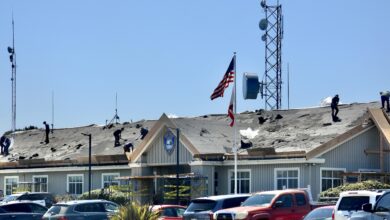Local wave energy tests can now get in the ocean faster
The federal agency that has taken control of wave energy has cut by 80 percent the time required to get experimental projects into the water.
The plan has widespread support, despite the lack of any process that ensures local control and questions about the legitimacy of the Federal Energy Regulatory Commission”s current control of the process.
Waters off the Mendocino Coast from Little River to Ten Mile have been claimed by two corporate giants who didn”t tell local governments about their federal filings beforehand. The state, which owns the ocean floor for three miles from the shore, has also been left out.
The same wave energy rush is happening faster than a breaking barrel north to the Canadian border.
“This is like the Wild West. People are staking claims, people are jumping claims and there is no sheriff,” said Richard Charter, co-chair of the Outer Continental Shelf Coalition.
The Federal Energy Regulatory Commission, also known as FERC, announced last week plans that would allow wave energy pilot projects to send electricity to shore after six months of permitting, rather than the three years now required.
Energy activist George Reinhardt of Fort Bragg is promoting an effort to create an energy element in the county general plan which he says could define a local voice, an idea county Supervisor Kendall Smith likes but which has yet to garner inland support.
An effort by Lincoln County, Ore., to stake a claim to control development of wave energy immediately offshore has been rebuffed in practical terms by a FERC filing demanding that the county commit only to a specific project and timeline.
In other words, there is now only room in the process for energy companies.
Charter said legalities are different in California, where the State Lands Commission claims rights to those three miles.
“Nobody has looked through California”s situation with lawyers yet, but we may be headed for a confrontation between the State Lands Commission and FERC,” Charter said.
Charter spoke to the newspaper from a conference in Oregon where he was about to give a presentation on how all control now stops at the seashore.
“There is no public interest zoning, no general plan whatsoever on what goes on in the ocean,” Charter said.
“What we are seeing is industrialization of the ocean … Manifest Destiny swept across the nation in the 19th century and has now swept on out in the ocean,” he said.
The only local government action so far has been the City of Fort Bragg playing host to discussions of wave energy and encouraging the Pacific Gas and Electric Company to bring more information about their proposal.
“The City Council has endorsed the concept of wave energy as a promising opportunity to help California in its effort to achieve energy independence,” City Councilman Dan Gjerde said. Gjerde has questioned the specifics of the two projects that have been proposed.
Most members of the City Council haven”t formulated any opinion on the issue and didn”t provide comment on the issue. Reinhardt has taken the lead on an issue deemed too complex and preliminary by many.
FERC Chairman Joseph T. Kelliher announced last week “a major step to reduce the regulatory barriers to the success of these new technologies with pilot projects to demonstrate these new technologies.”
The pilot project license would be available to small projects that are able to be shut down and removed on relatively short notice and not located in waters with sensitive designations.
Both PG&E and Chevron propose just such a pilot project locally as phase one of proposals that would eventually lead to much larger power plants.
“We would envision the license having a short term, perhaps five years. At the end of that period the project developer could apply for a standard license or decommission and restore the site. The pilot project license would … allow the Commission to alter operation to prevent unacceptable environmental effects,” Kelliher said in the announcement of the faster process.
While Charter is afraid of the process being rushed, he said now is the time for very small-scale experiments.
FERC will hold a national technical conference in October in Portland to explore issues related to the new pilot license proposal that is expected to draw investors and officials from around the world.
Oregon leads nation in wave energy
The Pacific Northwest, especially Oregon, has become the epicenter of the recent swell in interest in wave energy, with Oregon counties involved for more than a year in the licensing processes and working with those who wish to develop the offshore waters. Oregon State University has become a world leader in research into both wave and tidal energy.
An American Indian Tribe is operating the only working wave energy facility in the United States, a pilot project at Makah Bay, Wash., utilizing buoy technology, that FERC says is providing crucial information.
“Quickly behind Oregon is the Mendocino Coast, with these large scale players making claims,” Charter said.
“The City of Fort Bragg may have invited in the developers without anyone thinking, should local governments assert jurisdictional authority first?”” Charter said.
Who”s in charge?
Charter and Reinhardt feel there is still time for local governments and residents to play catch-up on the issue without much being lost.
At the federal level, FERC”s authority on the issue has been challenged by a fellow federal agency, the National Marine Fisheries Service, which regulates virtually everything but energy in the ocean. The service has inserted itself into the process, but the relationship between agencies at all levels remains unclear to all involved, federal filings show.
FERC itself has questioned its own process, which it modeled on hydroelectric permitting, because dams were the closest thing to ocean energy in the FERC playbook.
The California Coastal Commission, which has a say with anything that goes on up to the water”s edge, has little authority until wave energy comes ashore for maintenance facilities and with the needed cables.
Somewhat ironically, Chevron is able to file for a federal permit for wave energy in an area immediately offshore where all other energy sources, such as oil, natural gas and minerals, are controlled by the State Lands Commission.
Congress could change everything
The subject has yet to generate much interest in Congress.
Wave energy is hampered by the fact the issue does not motivate Republican or Democratic platforms. While Democrats, whose power is strongest in coastal regions around the nation, back any energy source that can reduce dependence on oil, they have been troubled by potential environmental and fishing impacts. Yet, the scientific community continues to sound louder and louder alarms about world oil supplies, as oil prices soar to levels unimagined in the 1980s. Utah Republican Sen. Orrin Hatch has been a key voice in promoting more study of wave energy, but neither party has put the issue on their radar.
The Oregonian newspaper reported last week that Rep. Darlene Hooley is moving legislation through Congress that would authorize $250 million in federal grants to research and develop wave energy over five years.
“Hooley”s proposal, which the House Science Committee included in an energy bill moving through the House, would represent the United States” first major investment in wave energy,” the newspaper reported.
Charter said something much, much bigger could happen in Congress that could change the face of the oceans very quickly.
“Congress in January discovered carbon. They were 20 years late but now they are discussing expanding the production tax credit for low carbon electricity generation,” said Charter.
“If that tax credit is changed in a certain way, wave energy becomes the new Manhattan Project. Everything would really accelerate. This could happen in this Democratic Congress and their attitude could be get out of the way we are going to do this,”” Charter said.
The coast”s Congressman, Mike Thompson, issued a statement of cautious support of the issue and promised to work with local communities on wave energy.
“The North Coast holds tremendous potential for the development of wave energy, perhaps more so than any other area of the Pacific Outer Continental Shelf,” Thompson said.
The FERC announcement of greatly shortening the permitting process is allowed under current laws, meaning the pilot study project”s permits could be issued now, Kelliher”s announcement says.
But local agencies would still be involved, FERC says.
“For the pilot license to work, it will be necessary for federal and state agencies to identify any necessary environmental studies early in the process, and issue any necessary permits in due course,” the chairman wrote.
Bush administration leadership questioned
Kelliher was appointed to the Federal Energy Regulatory Commission and later picked as chairman by President George W. Bush. Before joining the Department of Energy, he served on the Bush/Cheney Presidential Transition Team and has been with the administration since the president”s first inauguration. He is a disciple of allowing markets to guide and determine federal processes, media accounts state.
Charter fears the administration”s track record of not listening to science or input.
“This administration has shown it doesn”t listen to any arguments and we could have vast acceleration of this technology despite impacts on fishing, whales, seabirds and local communities,” said Charter.
But the idea of the need for more study of wave energy has bipartisan support, including from Charter and Thompson.
“Right now, we have very little information about wave energy”s impact. It is very important to conduct more research on wave energy so we can make the most informed decisions about how to best develop and regulate these renewable energy sources,” Thompson said.
National engineering and ocean publications say six months is faster than possible and that, even with the change, projects will take at least a year to get into the water.
“When you have any new technology society decides it might want to adopt, it is important to have prototypes tested so that we only make a small mistake,” Charter said.
“For Mendocino, this is not to take a go-slow attitude but to try on a limited scale and see what the impacts are going to be, to see where there is biofouling from the cables, what kind of chemicals are needed to remove marine growth, what the impact is on whale migrations, what fishermen will do to get around them when waters are stormy.”
Currently, a Federal Energy Regulatory Commission applicant wishing to study wave energy must seek a preliminary permit, which is issued for up to three years. This does not authorize construction; rather, it maintains the priority of an application while a company like Chevron studies the site and prepares to apply for a license. The company must submit periodic reports on the status of its studies. The proposal wouldn”t result in large scale plants coming online, only study proposals, like those proposed as phase one by both PG&E and Chevron off Mendocino County, although both companies also have plans for phase two, which would be plants up to 40 and 60 megawatts.
Charter said the prediction has been made that wave energy proposals will pop up at every point along the coast with a nearby electrical station, naming Point Arena, Bodega Head, Pigeon Point and perhaps others as possibilities for more projects.
“This is coming fast, more so than most people realize,” Charter said.




